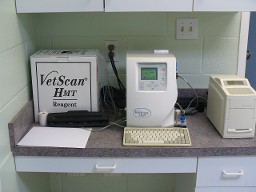 Veterinary dentistry is much more complex and time consuming than the human side of dentistry, so for this process general anesthesia and daytime hospitalization is required. The American Veterinary Dental College does not recommend dental cleanings without anesthesia because they do not allow cleaning or inspection below the gumline, where most dental disease occurs, and can result in injury to the pet or the person performing the procedure.
Veterinary dentistry is much more complex and time consuming than the human side of dentistry, so for this process general anesthesia and daytime hospitalization is required. The American Veterinary Dental College does not recommend dental cleanings without anesthesia because they do not allow cleaning or inspection below the gumline, where most dental disease occurs, and can result in injury to the pet or the person performing the procedure.
We highly recommend pre-surgical bloodwork be done to evaluate your pet's current health status and to assure safe anesthesia. A complete list of terminology and more specific reasons to do bloodwork is listed under "Facts and Forms".
When your pet is first brought in, a health exam will be given to ensure he is in fit condition to undergo the procedure. Following the exam, sedatives, pain meds and/or other drugs will be administered to help your pet remain calm and pain-free while under anesthesia. Equipment is used to monitor the animals' vital signs throughout the whole procedure (oxygen saturation, blood pressure, body temperature, etc), as safety is a priority for all our patients.
Once under anesthesia, full mouth digital dental radiographs are taken to evaluate the health of the bone and tissues below the gumline and grade the severity of periodontal disease. The veterinarian then uses the radiographs and visible exam of the teeth to do charting and determine which, if any, teeth need to be extracted. If extractions are indicated, regional nerve blocks are administered to prevent pain.
Our dental technician begins scaling the teeth with instruments similar to that used on humans. During this process, tartar and plaque are removed from the tooth surface and between the margins of the gums. After a thorough cleaning, the teeth are then polished, a flouride treatment is administered to help strengthen the teeth and ward off infection, and the technician performs a cold laser treatment on the gumline to reduce inflammation and pain.
Once the dental procedure is over, your pet is closely monitored and provided with heat support. Pain medications and/or anti-inflammatories are given by injection during recovery to ensure a smooth recovery and minimize any pain your pet could experience. The veterinarian will call you to go over the details of the dental findings and schedule a discharge time later that afternoon.
When you come to pick up your pet, a veterinary technician or a Doctor will go over the discharges and medications with you and discuss instructions for home recovery. We will also set up a recheck appointment in 3-4 weeks for the veterinarian to evaluate your pet's healing process.
IMPORTANT THINGS TO KEEP IN MIND:
1. Do NOT feed your pet after 8:00 the night before the procedure; food in the stomach can harmfully interact with the anesthesia.
2. You will be scheduled for an admittance appointment between 7:00-8:00 AM the morning of the procedure; by doing this, we will be able to get all vitals and diagnostics on your pet first thing, so when the doctors arrive, they will be all set to go.
3. The doctors will keep you updated on your pet's condition during the recovery stage. Please leave as many phone numbers as needed so we may be able to reach you, thus preventing any communication problems.
4. On a normal day, your animal will be ready to go home and scheduled for a discharge appointment between 3:00 and 5:00PM. The time may change slightly, but we will let you know what we think is the most comfortable and beneficial for you and your pet.
